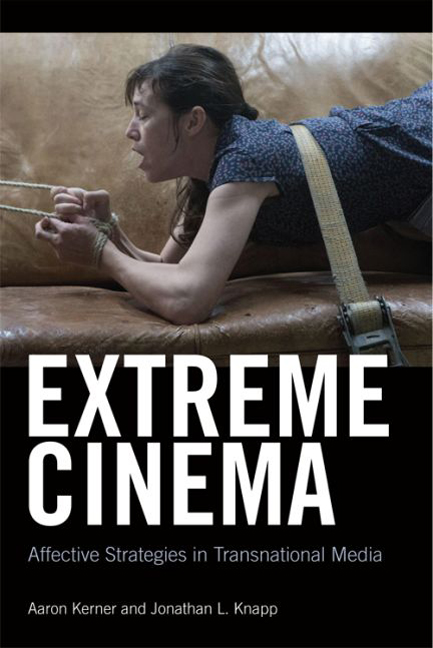Book contents
- Frontmatter
- Contents
- List of Figures
- Acknowledgments
- 1 Extreme Cinema: Revisiting Body Genres
- 2 Hearing: With a Touch of Sound—The Affective Charge of Audio Design
- 3 Pain: Exploring Bodies, Technology, and Endurance
- 4 Laughter: Belly-aching Laughter
- 5 Arousal: Graphic Encounters
- 6 Crying: Dreadful Melodramas—Family Dramas and Home Invasions
- 7 The End of Extreme Cinema?
- Bibliography
- Filmography
- Index
1 - Extreme Cinema: Revisiting Body Genres
- Frontmatter
- Contents
- List of Figures
- Acknowledgments
- 1 Extreme Cinema: Revisiting Body Genres
- 2 Hearing: With a Touch of Sound—The Affective Charge of Audio Design
- 3 Pain: Exploring Bodies, Technology, and Endurance
- 4 Laughter: Belly-aching Laughter
- 5 Arousal: Graphic Encounters
- 6 Crying: Dreadful Melodramas—Family Dramas and Home Invasions
- 7 The End of Extreme Cinema?
- Bibliography
- Filmography
- Index
Summary
INTRODUCTION: WHAT IS EXTREME CINEMA?
What is extreme cinema? That is the question we intend to explore. In the decade leading up to the millennium, and in the years since then, we have witnessed the emergence of films that have pushed against, if not breached, conventions regarding the treatment of sex and violence in the cinema. For instance, self-appointed morality police, exasperated film scholars and critics decried films such as Eli Roth's 2005 film Hostel —charging the film with being too excessive, and dismissing it as “pornographic,” “sadistic,” or both. If nothing else, the near hysterical response to extreme cinema reveals that it appeals to the visceral experience of the viewer. And repeatedly, these films are accused of disregarding narrative conventions in favor of grandiose spectacles of gore and violence that play to the spectator's baser senses. Extreme cinema, then, is frequently associated with excessive brands of horror, or trends, for instance, in contemporary French cinema (or “New French Extremity” as James Quandt called it) featuring elements of brutal violence sometimes coupled with graphic sexual imagery. We have no intention of disabusing the reader of these presumptions regarding extreme cinema, but would add to this, among other things, humor—the kind that makes one laugh so much it hurts. Furthermore, while the content of extreme cinema attracts considerable attention, and might be its most obvious feature, in many instances these films also experiment with form—composition, audio design, editing strategies. We survey here a wide range of international films that might be associated with extreme cinema.
We take Linda Williams's landmark essay “Film Bodies: Gender, Genre, and Excess” as something of a touchstone. Williams positions melodrama, horror, and pornography as the tripartite group of films that constitute the body genres. In all cases the spectator is invited to viscerally share in the experience of ecstatic screen-bodies. Melodrama might elicit tears, pornography intends to sexually arouse, and horror might startle us, making us jump from our seats, gasp, cringe, or avert our eyes at the sight of gore. In contemporary American horror, dubbed torture porn—Saw and Hostel being the most representative films of this type—bodies are torn asunder, wrenched, and contorted.
- Type
- Chapter
- Information
- Extreme CinemaAffective Strategies in Transnational Media, pp. 1 - 20Publisher: Edinburgh University PressPrint publication year: 2016



